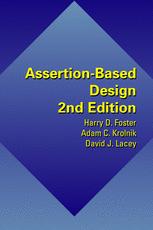

Most ebook files are in PDF format, so you can easily read them using various software such as Foxit Reader or directly on the Google Chrome browser.
Some ebook files are released by publishers in other formats such as .awz, .mobi, .epub, .fb2, etc. You may need to install specific software to read these formats on mobile/PC, such as Calibre.
Please read the tutorial at this link: https://ebookbell.com/faq
We offer FREE conversion to the popular formats you request; however, this may take some time. Therefore, right after payment, please email us, and we will try to provide the service as quickly as possible.
For some exceptional file formats or broken links (if any), please refrain from opening any disputes. Instead, email us first, and we will try to assist within a maximum of 6 hours.
EbookBell Team

4.7
16 reviewsChapter 3 Specifying RTL Properties 61 3. 1 Definitions and concepts 62 62 3. 1. 1 Property 3. 1. 2 Events 65 3. 2 Property classification 65 Safety versus liveness 66 3. 2. 1 3. 2. 2 Constraint versus assertion 67 3. 2. 3 Declarative versus procedural 67 3. 3 RTL assertion specification techniques 68 RTL invariant assertions 69 3. 3. 1 3. 3. 2 Declaring properties with PSL 72 RTL cycle related assertions 73 3. 3. 3 3. 3. 4 PSL and default clock declaration 74 3. 3. 5 Specifying sequences 75 3. 3. 6 Specifying eventualities 80 3. 3. 7 PSL built-in functions 82 3. 4Pragma-based assertions 82 3. 5 SystemVerilog assertions 84 3. 5. 1 Immediate assertions 84 3. 5. 2Concurrent assertions 86 3. 5. 3 System functions 95 3. 6 PCI property specification example 96 3. 6. 1 PCI overview 96 3. 7 Summary 102 Chapter 4 PLI-Based Assertions 103 4. 1 Procedural assertions 104 4. 1. 1 A simple PLI assertion 105 4. 1. 2 Assertions within a simulation time slot 108 4. 1. 3 Assertions across simulation time slots 111 4. 1. 4 False firing across multiple time slots 116 4. 2 PLI-based assertion library 118 4. 2. 1 Assert quiescent state 119 4. 3 Summary 123 Chapter 5 Functional Coverage 125 5. 1 Verification approaches 126 5. 2 Understanding coverage 127 5. 2. 1 Controllability versus observability 128 5. 2.